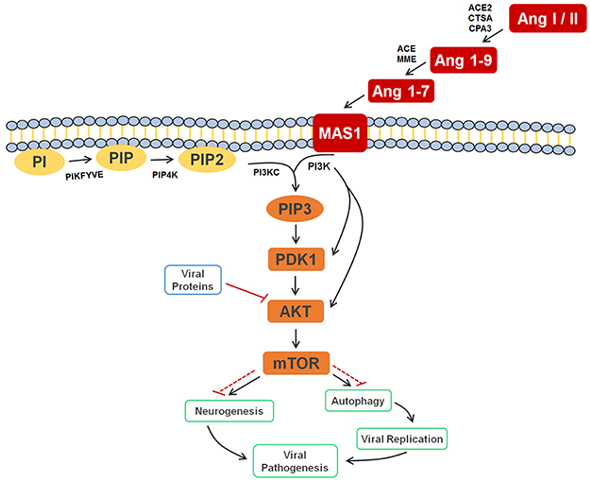Metabolomics in ZIKV Infection
Zika virus (ZIKV) is mainly transmitted by the Aedes aegypti mosquito. The disease has become a global health problem since it emerged in the Western Hemisphere in 2013. Studies have demonstrated that ZIKV infection can lead to changes in cell metabolism and directly affect neural development. Cell proliferation and maturation are dependent on cell metabolism, which is necessary for brain growth. To further understand the surrounding underlying mechanisms of ZIKV infection, metabolomics has been widely applied. Here, we focus on the works involving metabolomic approaches in studying ZIKV infection.
 Fig1. Cell signaling pathway scheme of metabolic alterations due to Zika virus infection. (Melo, C. F. O., et al, 2017)
Fig1. Cell signaling pathway scheme of metabolic alterations due to Zika virus infection. (Melo, C. F. O., et al, 2017)
Zika virus (ZIKV)
Zika virus (ZIKV) belonging to the Flaviviridae family, Flavivirusgenus, has recently been the focus of immense investigation due to its correlation to neurological syndromes and congenital developmental deficits. ZIKV can lead to varying degrees of disease in adults (ranging from a mild, febrile illness to severe neurological disorders) and cause congenital malformations and microcephaly in newborns.
Metabolomics applications in ZIKV
Understand the mechanisms of ZIKV infection
Researchers used direct-infusion mass spectrometry (DI-MS) and statistical analysis to study the pathophysiological process of ZIKV infection. In the investigation, biomarkers associated with the pathophysiological process of ZIKV were identified, including angiotensin and angiotensin I, ganglioside GM2, and a series of phosphatidylinositols. Among them, angiotensin involved in viral replication, gangliosides involved in viral membrane receptors associated with Guillain-Barré syndrome, and phosphatidylinositols took part in cellular signaling processes.
To investigate congenital Zika syndrome and microcephaly, metabolomics-based methods were used to assess saliva and serum from infants whose mothers were infected with ZIKV. In the study of non-invasive, metabolomics-based screening of saliva from infants with congenital Zika syndrome (CZS), hepoxilin and derivatives of prostaglandins were identified as possible anti-inflammatory biomarkers. Besides, researchers suggested that microcephaly was a product of the host immune response. In addition, a more recent study employed an untargeted metabolomics approach to analyze serum samples from ZIKV-positive newborns with or without microcephaly. Significant alterations in metabolites were observed, involving amino acids, carbohydrates and their derivatives, providing clues to the metabolic processes associated with ZIKV infection and microcephaly.
Identify metabolic changes for diagnosis of ZIKV-related diseases
MS-based metabolomics combined with machine learning (ML) prediction model has been used for rapid and accurate diagnosis of ZIKV. This method is reported to be able to identify patients up to 30 days after infection (i.e., after the acute phase). The results provided by the method are consistent with these obtained by RT-PCR (a common diagnostic method). Researchers believe this approach has the potential to be a powerful tool for zika virus diagnosis, as well as a large database providing epidemiological and pathological information.
Metabolomics, the investigation of the metabolites produced by or altered in an organism, serves as a valuable approach to the study of complex diseases. Creative Proteomics has been developing metabolomics detection and data analysis methods for many years. Based on professional scientists and advanced platforms, we can accelerate our customers' projects to the next level. For more information on how we can help you, please feel free to contact us.
References
- Nunes, E. D. C., & Canuto, G. A. B. (2020). "Metabolomics applied in the study of emerging arboviruses caused by Aedes aegypti mosquitoes: A review." Electrophoresis, 41(24), 2102-2113.
- Melo, C. F. O., et al. (2017). "Serum metabolic alterations upon Zika infection." Frontiers in microbiology, 8, 1954.
Related services
* For research use only.

 Fig1. Cell signaling pathway scheme of metabolic alterations due to Zika virus infection. (Melo, C. F. O., et al, 2017)
Fig1. Cell signaling pathway scheme of metabolic alterations due to Zika virus infection. (Melo, C. F. O., et al, 2017)